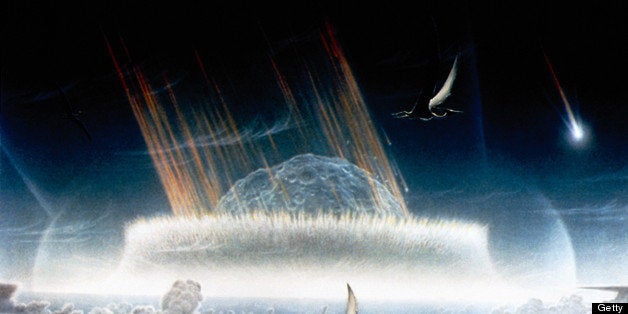
When an asteroid or comet slammed into Earth about 66 million years ago, most of our planet’s species were wiped out in a mass extinction—including entire groups such as the nonavian dinosaurs, marine reptiles such as mosasaurs, and their flying kin the pterosaurs. But not all ecosystems suffered equally, and the dramatic difference in survival rates between marine species and freshwater ones has been particularly puzzling. A new study weighs in on the long-standing riddle.
According to some estimates, about three-quarters of the plant and animal species on Earth disappeared during the end-of-the-Cretaceous dino-killing impact. But marine ecosystems lost only about half of their species, and freshwater environments lost a mere 10% to 22%, says William Lewis, an aquatic ecologist at the University of Colorado, Boulder. For instance, only about 10% of the major groups of bony fish died out, but species from all six groups of turtles alive at the time—and from most if not all groups of amphibians—survived the impact. The disparity with marine ecosystems began to make sense, he notes, when researchers began thinking of the mass extinction as a one-two punch: the fiery aftermath of the extraterrestrial impact, followed by a “nuclear winter”-like cold spell triggered by the smoke, soot, and myriad other tiny particles flung high into the atmosphere.
In the wake of the impact, creatures in marine and freshwater ecosystems experienced three particularly strong stresses: starvation brought about by the collapse of the food chain (and especially by the lack of photosynthesis), the reduction or loss of dissolved oxygen in the water, and low temperatures. But in many cases, species living in freshwater environments had advantages over sea creatures that bolstered their chances of survival, Lewis and his colleagues explain this month in the Journal of Geophysical Research: Biogeosciences. Not that the animals living in lakes and rivers escaped unscathed, Lewis says: “A lot of them died, too, it’s just that many species as a whole were able to persist until conditions returned to something near normal.”
For instance, researchers have previously estimated that sunlight couldn’t reach Earth’s surface for at least several months after the impact. For the many species that depend on plants and photosynthetic microorganisms at the base of the world’s food web, that was catastrophic. Based on body size and metabolic requirements, Lewis and his colleagues estimate that all creatures weighing less than 100 grams (or measuring less than 10 centimeters long) would have starved to death if postimpact darkness lasted between 3 and 6 months—unless, they emphasize, the organisms were also adapted to scavenge for a living or if they typically became dormant in cold, harsh conditions. (Many ancestors of today’s mammals are presumed to have survived the mass extinction because they lived in burrows and were somewhat protected from the firestorm and then the global cold spell following the impact.)
Those are the same adaptations that enable creatures living in lakes and rivers at high latitudes to survive a normal winter, when the bodies of water freeze over and 24-hour darkness reigns for weeks or months at a time, Lewis says.
With so many aquatic plants and animals dying en masse after the impact, decomposition would have robbed the water of much of its dissolved oxygen, Lewis says. Again, however, creatures in high-latitude freshwater ecosystems often experience such conditions each winter when ice blocks the exchange of oxygen from the overlying air. In contrast, conditions in marine ecosystems are typically steadier, so creatures living there haven’t evolved much tolerance for dramatic changes in temperature or oxygen levels—and hence those species died out at much higher rates.
And finally, while global temperatures may have plummeted after the impact, some portions of freshwater ecosystems may have been somewhat insulated from change. That’s because many lakes and streams get substantial amounts of their water not from surface runoff but from groundwater seepage—water that typically enters the streams at a steady temperature year-round, Lewis says.
The new paper is “an extremely thorough review of the issues and patterns of freshwater versus marine extinction patterns and mechanisms,” says Thomas Holtz Jr., a paleontologist at the University of Maryland, College Park. “It looks like the [team] tied together a disparate bunch of lines of evidence into a nicely coherent whole.”
Scientists have long suggested many of the characteristics that helped freshwater creatures survive the dino-killing mass extinction, but Lewis says that the new paper is the first one to put all the pieces together.
The team’s analysis “basically tells the story I’ve been telling my students for years,” Holtz says: While many species in the marine realm starved when the base of the food chain collapsed, he notes, the bottom-feeders there—as well as many species in freshwater ecosystems—were taking advantage of stored sources of nutrients such as nutrient-rich runoff from the land and previously accumulated organic material. In a sense, he says, they were “eating from the pantry,” so they suffered less severely.
ScienceNOW, the daily online news service of the journal Science
